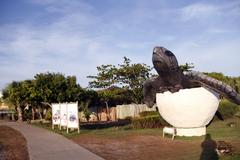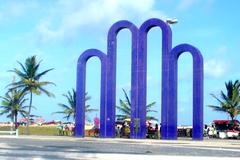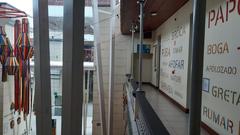Palácio Museu Olímpio Campos: Visiting Hours, Tickets, and Historical Sites in Aracaju, Brazil
Date: 03/07/2025
Introduction
Located in the vibrant heart of Aracaju, Sergipe, the Palácio Museu Olímpio Campos (PMOC) is one of Brazil’s most significant symbols of political and cultural heritage. Built in the mid-19th century and named after the influential politician Olímpio Campos, the palace has witnessed pivotal moments in both Sergipe and Brazilian history. Over time, it has transformed from the seat of state government into a dynamic museum and cultural center, offering locals and visitors a rare window into the state’s historic journey and architectural richness (Palácio Museu Olímpio Campos - Governo de Sergipe; Visit Aracaju - Palácio Museu Olímpio Campos).
Whether you are a history buff, architecture enthusiast, or cultural traveler, this guide provides comprehensive insights into the PMOC’s history, cultural significance, visitor logistics—including hours and tickets—nearby attractions, and practical tips for a memorable experience.
Table of Contents
- Origins and Construction
- Political and Social Role in Sergipe’s History
- The Legacy of Olímpio Campos
- Architectural Evolution and Restoration
- Museum Transformation and Collections
- Visitor Information: Hours, Tickets, and Tours
- Accessibility, Facilities, and Travel Tips
- Thematic Rooms and Exhibitions
- Temporary Exhibitions and Cultural Events
- Educational and Community Initiatives
- Nearby Attractions and Suggested Itineraries
- Frequently Asked Questions (FAQ)
- Conclusion
- References
Origins and Construction
The Palácio Museu Olímpio Campos was commissioned in 1863, just a few years after Aracaju was designated the capital of Sergipe in 1855. Completed in 1866, the palace’s neoclassical style reflected the modernization spirit sweeping through the city and state at the time. The building’s architecture, with its ornate columns, grand staircases, and imported European tiles, was designed to symbolize both governmental authority and Sergipe’s aspirations for progress (turismosergipe.com.br).
Political and Social Role in Sergipe’s History
For over a century, the Palácio served as the epicenter of Sergipe’s executive power. It was the setting for the succession of governors, the signing of major decrees, and critical ceremonies—witnessing the transition from the Brazilian Empire to the Republic and landmark political reforms. Its halls have welcomed important political figures and hosted events that shaped the trajectory of the state (Visit Aracaju - Palácio Museu Olímpio Campos).
The Legacy of Olímpio Campos
Named in honor of Olímpio Campos—a senator, lawyer, and journalist dedicated to the advancement of Sergipe—the palace pays homage to his tireless advocacy for state modernization and institutional reform during the late 19th and early 20th centuries. This legacy remains central to the museum’s mission of preserving Sergipe’s political and cultural history.
Architectural Evolution and Restoration
While the original neoclassical design has been largely maintained, the palace underwent significant renovations in the 1920s, notably influenced by an Italian artistic mission that added eclectic European touches. After ceasing to serve as the governor’s residence in the 1990s, the building was meticulously restored to preserve its architectural integrity, culminating in its reopening as a museum in 2005 (Palácio Museu Olímpio Campos - Governo de Sergipe; sergipeturismo.com.br).
Museum Transformation and Collections
As a museum, the PMOC houses extensive collections of original furnishings, artworks, historical documents, and artifacts from Sergipe’s political elite. Carefully curated rooms replicate the ambiance of different historical eras, providing an immersive look at the state’s evolution from a colonial outpost to a modern administrative center. In addition to its permanent collections, the museum frequently hosts temporary exhibitions, educational programs, and cultural events (Visit Aracaju - Palácio Museu Olímpio Campos).
Visitor Information: Hours, Tickets, and Tours
Location: Praça Fausto Cardoso, Centro, Aracaju, SE, Brazil
Opening Hours:
- Tuesday to Friday: 9:00 AM – 4:30 PM
- Saturday: 9:00 AM – 12:30 PM
- Closed on Mondays and public holidays (se.gov.br)
Admission: Free; no tickets or prior reservations required.
Guided Tours:
- All visits are guided by trained monitors, including university students in history, tourism, and museology.
- Guided tours last 40–55 minutes and cater to groups of up to 12 people.
- For small groups, advance booking is not necessary (pacotebarato.com.br).
Accessibility, Facilities, and Travel Tips
- Accessibility: The museum is located in a central, flat area accessible to visitors with limited mobility. Some upper-floor rooms may have restricted access due to the building’s historical structure.
- Facilities: Cloakrooms are available for personal belongings; restrooms are provided; there is no on-site café.
- Travel Tips: Arrive early for guided tours, especially on weekends or during special exhibitions. Morning visits are recommended for a quieter experience.
- Nearby Transportation: PMOC is easily accessible by public buses, taxis, and ride-sharing services. Parking is available nearby.
Thematic Rooms and Exhibitions
The PMOC is organized into thematic areas that narrate Sergipe’s political, social, and artistic evolution (turismosergipe.com.br):
- Espaço Província & Espaço República: Documents and portraits illustrating the shift from the imperial to republican era.
- Espaço Arnaldo Garcez: Interactive displays on Aracaju’s founding, palace history, and key influencers.
- Espaço Fausto Cardoso: Focused on the legacy of Fausto Cardoso, a pivotal political figure.
- Galeria de Artes Eurico Luiz: Artworks by Sergipano artists, historical artifacts, and ceiling paintings celebrating regional culture.
- Upper Floor: Preserved governor’s residence rooms with period furniture and original decorative elements.
Temporary Exhibitions and Cultural Events
The museum regularly hosts temporary exhibitions and cultural programs that celebrate Sergipe’s artistic diversity. Recent highlights include:
- Exhibition “Rosa Faria e a Arte de Retratar Aracaju” (2024): Works by Rosa Faria, honoring Aracaju’s 170th anniversary and International Women’s Month.
- Photography & Visual Arts: Showcasing artists such as Michel de Oliveira (jornaldacidade.net).
Educational and Community Initiatives
Committed to education, the PMOC offers guided tours, lectures, and workshops tailored to schools and the general public. Collaborations with universities and cultural organizations foster research and community engagement (turismosergipe.com.br).
Nearby Attractions and Suggested Itineraries
Enhance your visit by exploring other Aracaju landmarks within walking distance:
- Museu da Gente Sergipana: Interactive exhibits on local culture.
- Catedral Metropolitana: Notable for its religious and architectural significance.
- Centro Cultural de Aracaju: Focused on regional arts and traditions.
- Mercado Municipal: Local crafts and cuisine.
Create a cultural itinerary by combining these attractions for a comprehensive Aracaju experience (pacotebarato.com.br).
Frequently Asked Questions (FAQ)
Q: What are the Palácio Museu Olímpio Campos visiting hours?
A: Tuesday to Friday, 9:00 AM – 4:30 PM; Saturday, 9:00 AM – 12:30 PM. Closed on Mondays and public holidays.
Q: Is admission free?
A: Yes, all visitors enjoy free admission.
Q: Are guided tours required?
A: All visits are guided, and tours are included in your visit.
Q: Is the museum accessible for visitors with disabilities?
A: The building is mostly accessible, though some upper-floor areas may have restrictions due to its historic nature.
Q: Is photography allowed?
A: Photography is generally not permitted inside to protect the exhibits.
Conclusion
Palácio Museu Olímpio Campos stands as a living monument to Sergipe’s political and cultural development. From its neoclassical architecture and historic furnishings to its thematic exhibitions and educational initiatives, the museum offers a comprehensive exploration of the region’s heritage. Its central location, free admission, and guided tours make it an accessible and enriching destination for all.
For the most current information on visiting hours, exhibitions, and events, consult the official museum website. Enhance your visit by downloading the Audiala app for interactive guides, and follow local tourism platforms for updates.
Explore the Palácio Museu Olímpio Campos and connect with the vibrant history of Aracaju and Sergipe!
References
- Palácio Museu Olímpio Campos - Governo de Sergipe
- Visit Aracaju - Palácio Museu Olímpio Campos
- turismosergipe.com.br - Palácio Museu Olímpio Campos Reveals Historical Riches
- Fundação Aperipê - FUNCAP
- sergipeturismo.com.br - Palácio Museu Olímpio Campos
- pacotebarato.com.br - Palácio Museu Olímpio Campos
- whichmuseum.com - Palace Museum Olímpio Campos
- jornaldacidade.net - Exposição Tototos


